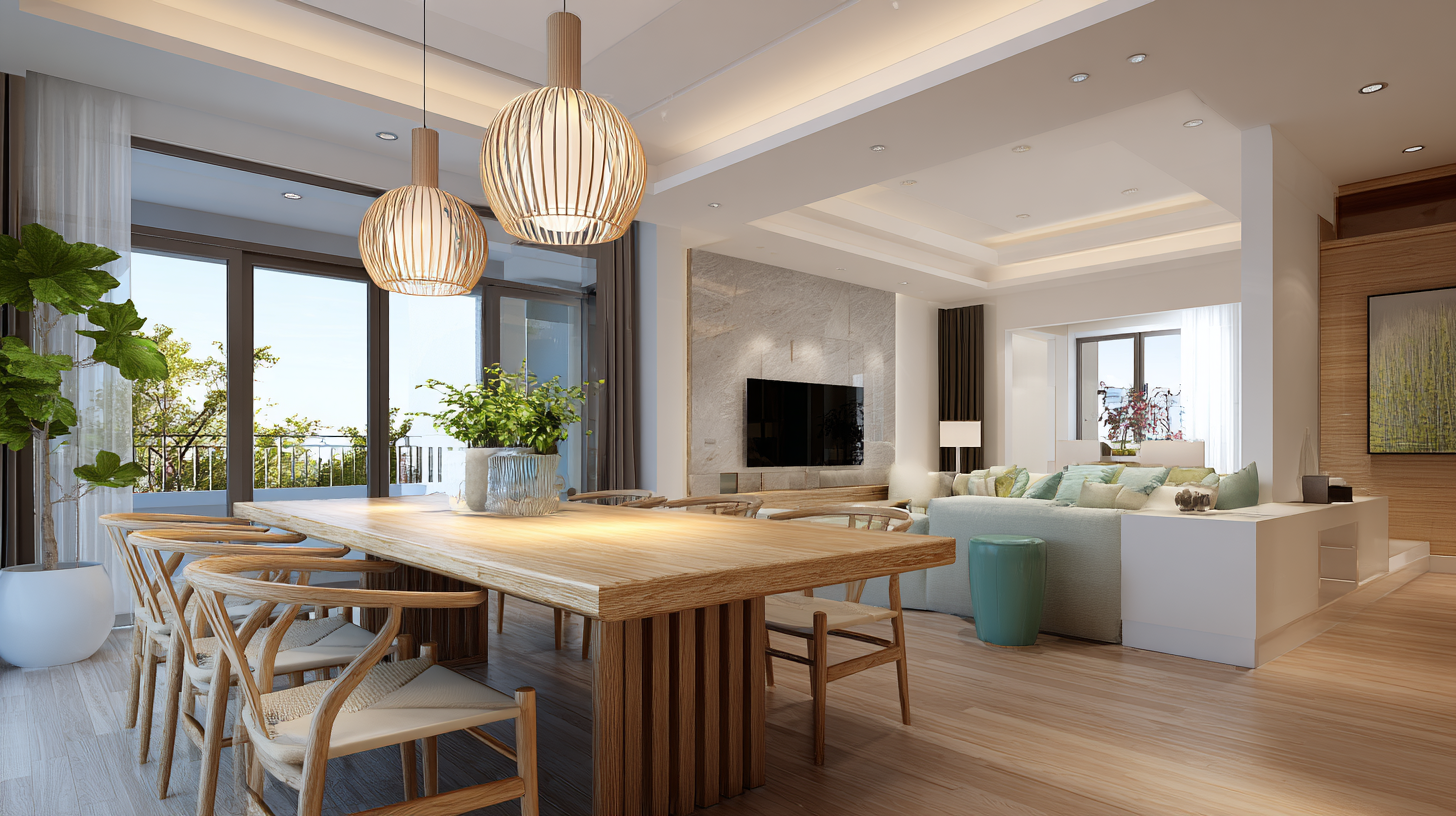Exploring the Future: How the Best Living Room Dining Table Will Evolve in 2025 and Beyond
As we venture into 2025 and beyond, the concept of the living room dining table is poised for significant transformation, driven by evolving consumer preferences and advancements in design technology. According to a recent report by the National Retail Federation, the furniture market is projected to grow by 5% annually, highlighting a rising demand for multifunctional pieces that blend aesthetics with practicality.
In this context, manufacturers are increasingly focused on sustainable materials and innovative designs that cater to diverse living spaces. The living room dining table, traditionally seen as a singular function piece, is expected to evolve into a versatile solution that meets social and spatial dynamics. As we explore the future of this essential furniture item, we will delve into key trends, certification standards for imports and exports, and practical tutorials for consumers and designers alike, ensuring we stay informed about the best practices in this ever-changing industry.

The Shift Towards Sustainable Materials in Dining Tables
As we look ahead to 2025 and beyond, the dining table's evolution in living rooms will prominently feature a shift towards sustainable materials. This transformation is guided by an increasing awareness of environmental challenges, including the need to mitigate plastic pollution and embrace renewable resources. For instance, the furniture industry is witnessing a marked trend favoring natural fiber composites, which provide eco-friendly alternatives to conventional materials. According to recent studies, these composites are made from renewable resources like jute and hemp, reducing the reliance on finite resources and contributing to a circular economy.
The broader context of this evolution is underscored by various global initiatives, such as Jordan's commitment to transitioning toward a circular economy, signifying a structural change in traditional economic models. This shift is echoed across industries, with recent reports indicating that eco-friendly styles are becoming a priority in furniture design. As consumers increasingly demand sustainable options, the implementation of environmentally responsible practices in production will not only bolster brand loyalty but also drive the market towards innovative materials that enhance sustainability. By 2025, we can expect living room dining tables to reflect this cultural shift, characterized by designs that prioritize longevity and minimal environmental impact.
Innovative Designs: Integrating Technology with Aesthetic Appeal
As we move towards 2025, the landscape of living room dining tables is set to transform significantly, driven by technological advancements and the evolving needs of modern consumers. According to a recent report by Allied Market Research, the global smart furniture market is projected to reach $1.4 billion by 2025, showcasing a growing demand for pieces that not only serve aesthetic purposes but also integrate seamlessly with technology. This evolution in design emphasizes the importance of multifunctional furniture, where dining tables will come equipped with features such as wireless charging, embedded touchscreen interfaces, and even IoT connectivity, allowing users to control lighting or streaming devices directly from their table.

Moreover, consumer preferences are shifting towards sustainable and ethically sourced materials. A study by the International Furniture Fair Singapore indicates that 70% of buyers consider sustainability in their purchasing decisions. As a result, innovative designs will incorporate eco-friendly materials that do not compromise on style or durability. Expect to see dining tables featuring natural wood, recycled materials, and biodegradable components, reflecting a harmony between technology, sustainability, and aesthetic appeal. This blend of form and function will redefine the living space, creating an environment that is both inviting and reflective of a modern lifestyle.
Functionality Meets Style: Adaptive Features in Future Tables
As we look towards 2025, living room dining tables are set to evolve significantly, merging functionality with style. One of the key aspects of future tables will be their adaptive features, designed to cater to various lifestyles and needs. Just as adaptive apparel has emerged to meet the requirements of individuals with disabilities, the dining table of the future will embrace similar principles. Features could include extendable surfaces that adjust in size based on the number of diners or multifunctional designs that convert seamlessly between dining and workspace.

This evolution reflects a broader trend towards utilizing adaptive design in various fields, from flood risk management to apparel. For example, adaptive strategies are becoming essential in responding to environmental challenges, such as climate change and food security. Similarly, the dining tables of the future might incorporate sustainable materials and innovative technologies that enhance usability while also addressing ecological considerations. By embracing adaptive features, these tables will not only serve as functional furniture but will also contribute to creating more versatile and resilient living spaces that respond to our changing lifestyles.
Smart Furniture: The Role of IoT in Dining Table Design
As we look toward the future, the integration of the Internet of Things (IoT) into furniture design is poised to revolutionize living spaces, particularly with dining tables. According to a recent report from MarketsandMarkets, the smart furniture market is expected to reach $79.6 billion by 2026, growing at a compound annual growth rate (CAGR) of 25% from 2021. This surge indicates a burgeoning trend in which dining tables will not only serve their traditional purpose but will also become multifunctional hubs for social interaction, entertainment, and even remote work.
Imagine a dining table equipped with touch-sensitive controls that allow users to adjust lighting, manage entertainment systems, or streamline meal preparation through connected kitchen appliances. Features such as integrated wireless charging mats, built-in speakers, and even self-cleaning surfaces are on the horizon. A study by Statista predicts that by 2025, around 75 billion devices will be connected to the internet globally, driving demand for smart furniture that can seamlessly integrate into our interconnected lifestyles. As these innovations unfold, the dining table will emerge as a cornerstone of everyday life, adapting to our evolving needs and enhancing our overall living experience.
Exploring the Future: How the Best Living Room Dining Table Will Evolve in 2025 and Beyond
| Feature | Description | Expected Impact | IoT Integration |
|---|---|---|---|
| Smart Connectivity | Tables that connect to home networks for smart device integration. | Increased convenience and interoperability with various devices. | Supports voice control and remote management. |
| Adjustable Height | Tables that can be adjusted for dining or casual use. | Enhances versatility for different dining experiences. | Can be controlled by apps for user-defined height settings. |
| Integrated Charging Stations | Built-in wireless chargers for smartphones and other devices. | Promotes connectivity and reduces cord clutter. | Can monitor battery levels and provide alerts. |
| Health Monitoring Features | Sensors that monitor the health of users during meals. | Can encourage healthier eating habits by tracking food intake. | Data synced with health apps for personalized insights. |
| Personalized Lighting | Integrated LED lighting that adjusts based on mood or events. | Creates an inviting atmosphere tailored to preferences. | Adjust lighting via smartphone or voice commands. |
Trends Shaping the Dining Experience: Social and Cultural Influences
As we delve into the dining experience of the future, it's crucial to recognize the social and cultural influences shaping our choices. In 2025 and beyond, our living room dining tables will likely reflect a more communal approach to dining. Families and friends will gather around tables designed for interaction, emphasizing conversation and connection. Expect round or organic-shaped tables that foster a sense of togetherness and make it easier to engage with one another.
Tip: When selecting a dining table, consider materials that encourage warmth and familiarity. Natural wood finishes can create an inviting atmosphere, while unique designs can serve as conversation starters.
Furthermore, the integration of technology in the dining space will redefine how we experience meals. Smart tables that can adjust height or feature built-in charging stations may start to appear. Additionally, sustainability will remain a significant driver, encouraging choices that favor eco-friendly materials and practices.
Tip: To enhance your dining experience, explore tables that offer multifunctionality, such as expandable designs for large gatherings or tables that incorporate storage for dining essentials. Prioritizing flexibility will help accommodate both intimate dinners and large celebrations, seamlessly blending style with utility.
